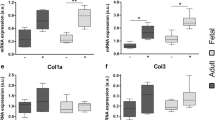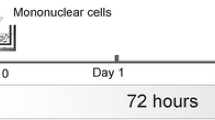Summary
Human fetal skin fibroblasts (TIG-3S) were found to migrate into a denuded area in a cell monolayer when cultured in both serum-depleted and serum-supplemented media, unlike adult-donor skin fibroblasts which migrated well only when cultured in serum-supplemented medium. Therefore, a series of experiments was carried out to determine whether autocrine factors are involved in their migration. The migration of TIG-3S cells in serum-depleted medium was suppressed by the addition of suramin, a factor with growth factor antagonist properties, which suggests that growth factors are important for cell migration. The suramin-induced inhibition was reversed completely by adding excess basic fibroblast growth factor (bFGF) to the culture medium and partially by platelet-derived growth factor (PDGF). Treatment with neutralizing anti-PDGF antibody did not suppress TIG-3S cell migration, whereas neutralizing anti-bFGF antibody did, which indicates that bFGF is an autocrine and PDGF a paracrine factor involved in cell migration. Next, an experiment was performed to ascertain whether the extracellular matrix is involved in TIG-3S cell migration. Monensin, an inhibitor of extracellular matrix secretion, inhibited cell migration, which was reversed by adding excess type I collagen, but not excess plasma fibronectin. In addition, further evidence for the involvement of collagen was provided by the observation that ethyl-3,4-dihydroxybenzoate, a specific inhibitor of collagen synthesis, suppressed cell migration. These results suggest that the autonomous migration of TIG-3S human fetal skin fibroblasts is mediated by bFGF and type I collagen, which they produce and secrete.
Similar content being viewed by others
References
Augustin-Voss, H. G.; Pauli, U. B. Quantitative analysis of autocrine-regulated, matrix-induced, and tumor cell-stimulated endothelial cell migration using a silicon template compartmentalization technique. Exp. Cell Res. 198:221–227; 1992
Betholez, C.; Westermark, E. R. B.; Heldin, C.-E. Coexpression of a PDGF-like growth factor and PDGF receptors in a human oesteosarcoma cell line: implications for autocrine receptor activator. Cell 39:447–457; 1984.
Boyden, S. V. The chemotactic effect of mixtures of antibody and antigen on polymorphonuclear leukocytes. J. Exp. Med. 115:453–466; 1962.
Clemmons, D. R. Age dependent production of a competence factor by human fibroblasts. J. Cell. Physiol. 114:61–67; 1983.
Coffey, B. J., Jr.; Leof, E. B.; Shipley, G. D., et al. Nature of the interaction of growth factor with suramin. J. Cell. Physiol. 132:143–148; 1987.
Flaumenhaft, R.; Moscatelli, D.; Saksela, O., et al. Role of extracellular matrix in the action of basic fibroblast growth factor: matrix as a source of growth factor for long-term stimulation of plasminogen activator production and DNA synthesis. J. Cell. Physiol. 140:75–81; 1989.
Gauss-Muller, V.; Kleinman, H. K.; Martin, G. R., et al. Role of attachment factors and attractants in fibroblast chemotaxisis. J. Lab. Clin. Med. 96:1071–1080; 1980.
Grey, A.-M.; Schor, A. M.; Rushton, G., et al. Purification of the migration stimulating factor produced by fetal and breast cancer patient fibroblasts. Proc. Natl. Acad. Sci. USA 86:2438–2442; 1989.
Kojima, S.; Harpel, P. C.; Rifkin, D. B. Lipoprotein (a) inhibits the generation of transforming growth factor-β: an endogenous inhibitor of smooth muscle cell migration. J. Cell Biol. 113:1439–1445; 1991.
Kondo, H.; Nomaguchi, T. A.; Sakurai, Y., et al. Effects of serum from human subjects of various ages on proliferation of human lung and skin fibroblasts. Exp. Cell Res. 178:287–295; 1988.
Kondo, H.; Nomaguchi, T. A.; Yonezawa, Y. Effects of serum from human subjects of different ages on migration in vitro of human fibroblasts. Mech. Ageing Dev. 47:25–37; 1989.
Kondo, H.; Yonezawa, Y.; Nomaguchi, T. A. Difference in migratory ability between human lung and skin fibroblasts. Zool. Sci. 7:39–46; 1990.
Kondo, H.; Yonezawa, Y. Changes in the migratory ability of human lung and skin fibroblasts during in vitro aging and in vivo cellular senescence. Mech. Ageing Dev. 63:223–233; 1992.
Kondo, H.; Matsuda, R.; Yonezawa, Y. Platelet-derived growth factor in combination with collagen promotes the migration of human skin fibroblasts into a denuded area of a cell monolayer. Exp. Cell Res. 202:45–51; 1992.
Martin, G. R. Laminin and other basement membrane components. Ann. Rev. Cell Biol. 3:57–85; 1987.
Matsuzaki, K.; Yoshitake, Y.; Matuo, Y., et. al. Monoclonal antibodies against heparin-binding growth factor II/basic fibroblast growth factor that block its biological activity. Proc. Natl. Acad. Sci. USA 86:9911–9915; 1989.
Middaugh, C. R.; Mach, H.; Burke, C. J., et al. Nature of the interaction of growth factor with suramin. Biochemistry 31:9016–9024; 1992.
Mignatti, P.; Morimoto, T.; Rifkin, D. B. Basic fibroblast growth factor released by single, isolated cells stimulates their migration on an autocrine manner. Proc. Natl. Acad. Sci. USA 88:11007–11011; 1991.
Minniti, C. P.; Maggi, M.; Helman, L. J. Suramin inhibits the growth of human Rhodomyosarcoma by interrupting the insulin like growth factor autocrine growth loop. Cancer Res. 52:1830–1835; 1992.
Mundy, G. R.; De Martino, S.; Rowe, D. W. Collagen and collagen-derived fragments are chemotactic for tumor cells. J. Clin. Invest. 68:1102–1105; 1981.
Nandan, D.; Clarke, E. P.; Ball, E. H., et al. Ethyl-3,4-dihydroxybenzoate inhibits myoblast differentiation: evidence for an essential role of collagens. J. Cell Biol. 110:1673–1679; 1990.
Pienta, K. J.; Isaacs, W. B.; Vindvich, D., et al. The effects of basic fibroblast growth factor and suramin on cell motility and growth of rat prostate cancer cells. J. Urol. 145:199–202; 1991.
Postlethwaite, A. E.; Seyer, J. M.; Kang, A. H. Chemotactic attraction of human fibroblasts to type I, II and III collagens and collagen-derived peptides. Proc. Natl. Acad. Sci. USA 75:871–875; 1978.
Postlethwaite, A. E.; Keski-Oja, J.; Moses, H. L., et al. Stimulation of the chemotactic migration of human fibroblasts by transforming growth factor-β. J. Exp. Med. 165:251–256; 1987.
Presta, M.; Maier, J. A. M.; Rusnati, M., et al. Basic fibroblast growth factor is released from endothelial extracellular matrix in a biologically active form. J. Cell. Physiol. 140:68–74; 1989.
Root, L. L.; Shipley, G. D. Human dermal fibroblasts express multiple bFGF and aFGF proteins. In Vitro Cell. Dev. Bio. 27A:815–822; 1991.
Rosen, E. M.; Goldberg, I. D. Protein factors which regulate cell motility. In Vitro Cell. Dev. Biol. 25:1079–1087; 1989.
Ruoslahti, E.; Pierschbacher, M. D. New perspectives in cell adhesion: RGD and integrins. Science 238:491–497; 1987.
Saksela, O.; Rifkin, D. B. Release of basic fibroblast growth factor-heparan sulfate complexes from endothelial cells by plasminogen activator-mediated proteolytic activity. J. Cell Biol. 110:767–775; 1990.
Sasaki, T.; Majamaa, K.; Uitto, J. Reduction of collagen production in Keloid fibroblast cultures by ethyl-3,4-dihydroxybenzoate. J. Biol. Chem. 262:9397–9403; 1987.
Sato, Y.; Rifkin, D. B. Autocrine activities of basic fibroblast growth factor: regulation of endothelial cell movement, plasminogen activator synthesis, and DNA synthesis. J. Cell Biol. 107:1199–1205; 1988.
Sato, Y.; Tsuboi, R.; Lyons, R., et al. Characterization of the activation of latent TGF-β by co-cultures of endothelial cells and pericytes or smooth muscle cells: a self regulating system. J. Cell Biol. 111:757–763; 1990.
Sato, Y.; Hamanaka, R.; Ono, J., et al. The stimulatory effect of PDGF on vascular smooth muscle cell migration is mediated by the induction of endogenous basic FGF. Biochem. Biophys. Res. Commun. 174:1260–1266; 1991.
Schor, S. L.; Schor, A. M.; Rushton, G., et al. Adult, foetal and transformed fibroblasts display different migratory phenotypes on collagen gels: evidence for an isoformic transition during foetal development. J. Cell Sci. 73:221–234; 1985.
Schor, S. L.; Schor, A. M.; Grey, A. M., et al. Foetal and cancer patient fibroblasts produce an autocrine migration-stimulating factor not made by normal adult cells. J. Cell Sci. 90:391–399; 1988.
Senior, R. M.; Griffin, G. L.; Mecham, R. P. Chemotactic responses of fibroblasts to tropoelastin and elastin-derived peptides. J. Clin. Invest. 70:614–618; 1982.
Senior, R. M.; Huang, S. S.; Griffin, G. L., et al. Brain-derived growth factor is a chemoattractant for fibroblasts and astroglial cells. Biochem. Biophys. Res. Commun. 141:67–72; 1986.
Seppa, H.; Grotendorst, G.; Seppa, S., et al. Platelet-derived growth factor is chemotactic for fibroblasts. J. Cell Biol. 92:584–588; 1982.
Stenn, K. S. Quantitative assay of dissociated tissue cell motility in vitro. In Vitro 16:357–360; 1980.
Stoker, M.; Gherardi, E. Regulation of cell movement: The motogenic cytokines. Biochim. Biophys. Acta 1072:81–102; 1991.
Uchida, N.; Smilowitz, H.; Tanzer, M. L. Monovalent ionophores inhibit secretion of procollagen and fibronectin from cultured human fibroblasts. Proc. Natl. Acad. Sci. USA 76:1868–1872; 1979.
Yonezawa, Y.; Kondo, H.; Kaji, K., et al. Species-specific differences in the mitogenic activity of heparin-binding growth factors in the sera of various mammals. Experientia 48:239–245; 1992.
Yoshida, T.; Kawase, M.; Sasaki, K., et al. Comparative studies on the sensitivity of three methods for detecting mycoplasmal contamination in cell cultures. Bull. Jpn. Fed. Cul. Coll. 4:9–15; 1988.
Wharton, W. Newborn human skin fibroblasts senescence in vitro without acquiring adult growth factor requirements. Exp. Cell Res. 154:311–314; 1984.
Author information
Authors and Affiliations
Rights and permissions
About this article
Cite this article
Kondo, H., Matsuda, R. & Yonezawa, Y. Autonomous migration of human fetal skin fibroblasts into a denuded area in a cell monolayer is mediated by basic fibroblast growth factor and collagen. In Vitro Cell Dev Biol - Animal 29, 929–935 (1993). https://doi.org/10.1007/BF02634231
Received:
Accepted:
Issue Date:
DOI: https://doi.org/10.1007/BF02634231




